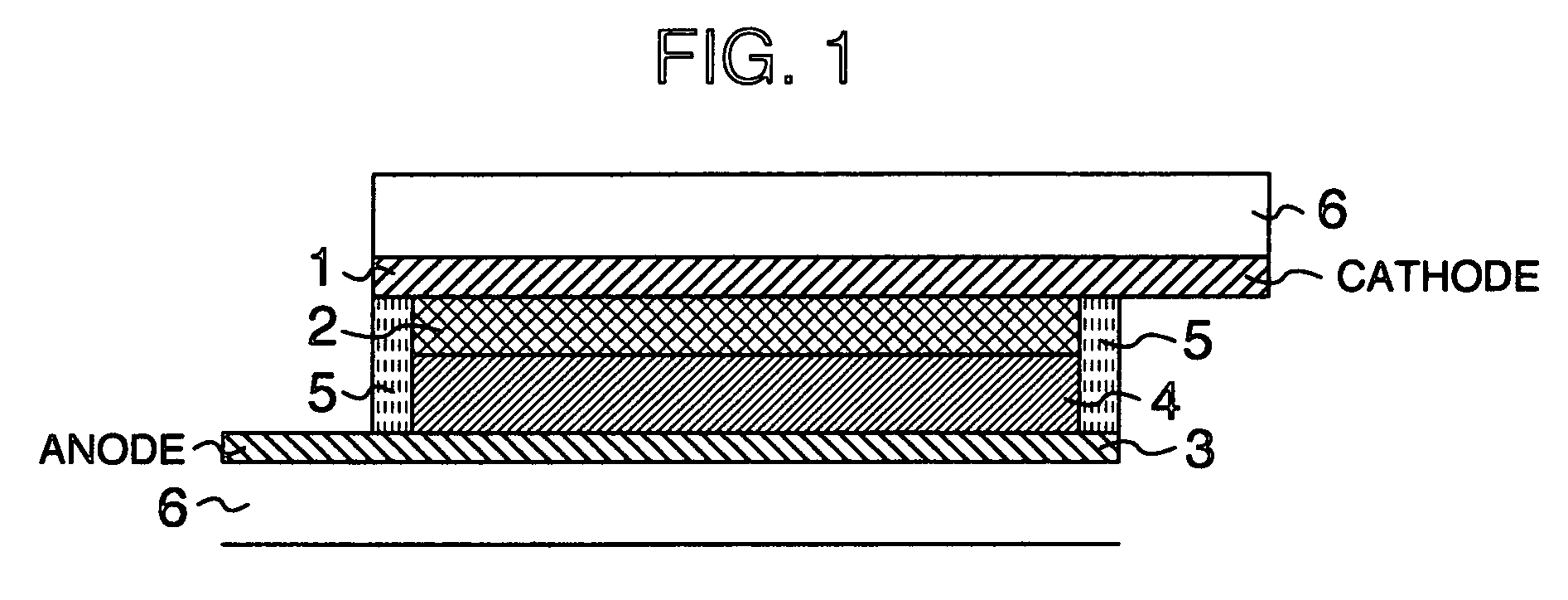Sealing Agent for Photoelectric Converter and Photoelectric Converter Using Same
a technology of sealing agent and photoelectric converter, which is applied in the field of sealing agent, can solve the problems of insufficient widespreadization, insufficient properties, and cost increase, and achieve the effects of excellent adhesion and moisture resistance reliability, high yield, and good application workability to substrates
- Summary
- Abstract
- Description
- Claims
- Application Information
AI Technical Summary
Benefits of technology
Problems solved by technology
Method used
Image
Examples
synthesis example 1
Synthesis of Ethylene Oxide Addition Bisphenol S Type Epoxy Resin (Epoxy Resin A)
[0087]To a flask equipped with a thermometer, a dropping funnel, a condenser, and a stirrer, 169 parts of SEQ-2 (a tradename for ethylene oxide addition bisphenol S manufactured by NICCA CHEMICAL CO., LTD., melting point: 183° C., and purity: 99.5%), 370 parts of epichlorohydrin, 185 parts of dimethyl sulfoxide, and 5 parts of tetramethylammonium chloride were added and dissolved with stirring; this solution was heated to 50° C. Then 60 parts of flake form sodium hydroxide were separately added thereto over 100 minutes; subsequently a reaction was further effected at 50° C. for 3 hours. After the reaction was complete, 400 parts of water was added thereto and this solution was washed. Excessive epichlorohydrin and the like were evaporated from an oil layer at 130° C. under a reduced pressure by using a rotary evaporator. To thus obtained residue, 450 parts of methyl isobutyl ketone was added and dissolv...
synthesis example 2
Synthesis of Ethylene Oxide Addition Bisphenol Fluorene Epoxy Resin (Epoxy Resin B)
[0089]In a flask equipped with a thermometer, a dropping funnel, a condenser, and a stirrer, under nitrogen gas purge, 220 parts of BPEF (a tradename for bisphenoxyethanol fluorene manufactured by OSAKA GAS CO., LTD., white solid, and melting point: 124 to 126) were dissolved in 370 parts of epichlorohydrin, and 5 parts of tetramethylammonium chloride was added thereto. This solution was heated to 45° C., and 60 parts of flake form sodium hydroxide were separately added thereto over 100 minutes; subsequently a reaction was further effected at 45° C. for 3 hours. After the reaction was complete, the solution was washed with water twice to remove generated salts. After that, excessive epichlorohydrin and the like were evaporated with heating to 130° C. under a reduced pressure by using a rotary evaporator. To thus obtained residue, 552 parts of methyl isobutyl ketone were added and dissolved. This methy...
example 1
[0091]Bisphenol F epoxy acrylate was obtained by reaction of RE-404P (a tradename for bisphenol F type epoxy resin manufactured by Nippon Kayaku Co., Ltd., epoxy equivalent: 160 g / eq, and hydrolyzable chlorine amount: 30 ppm) with 100% equivalent of acrylic acid based on an epoxy group; purification by a separating treatment with ion exchanged water / toluene; and subsequent evaporation of toluene. A resin solution was obtained by heating at 90° C. and dissolving 80 parts by weight of thus obtained bisphenol F epoxy acrylate, 20 parts by weight of epoxy resin A in Synthesis Example 1, as radical formation photo polymerization initiators, 1.8 parts by weight of ADEKA OPTOMER-N-1414 (a tradename for 3,6-bis(2-methyl-2-morphorinopropionyl)-9-n-octylcarbazole manufactured by Asahi Denka Co., Ltd.), and 1.2 parts by weight of KBM-603 (a tradename for an aminosilane coupling agent N-β(aminoethyl)γ-aminopropyltrimethoxysilane manufactured by Shin-Etsu Silicones). To this resin solution coole...
PUM
| Property | Measurement | Unit |
|---|---|---|
| average particle diameter | aaaaa | aaaaa |
| temperatures | aaaaa | aaaaa |
| particle diameter | aaaaa | aaaaa |
Abstract
Description
Claims
Application Information
 Login to View More
Login to View More - R&D
- Intellectual Property
- Life Sciences
- Materials
- Tech Scout
- Unparalleled Data Quality
- Higher Quality Content
- 60% Fewer Hallucinations
Browse by: Latest US Patents, China's latest patents, Technical Efficacy Thesaurus, Application Domain, Technology Topic, Popular Technical Reports.
© 2025 PatSnap. All rights reserved.Legal|Privacy policy|Modern Slavery Act Transparency Statement|Sitemap|About US| Contact US: help@patsnap.com



